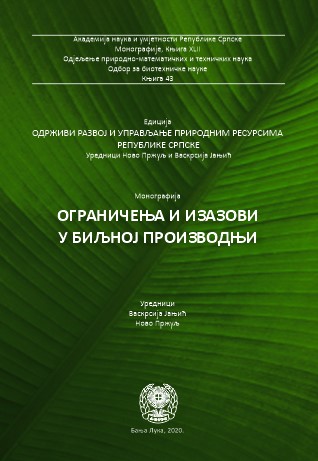Plant protection and resistance of harmful organisms
DOI:
https://doi.org/10.7251/EORU2003223JKeywords:
Plant protection, pesticides, weed plants, arthropods, mushrooms, resistance, harmful organismsAbstract
Cultivated plants are attacked and used as food by about 67.000 species of harmful organisms. Of that number, 900 species are insects and mites, 50.000 species are pathogenic microorganisms and 8.000 species are weed plants. In the countries with the intensive agricultural production it is considered that phytopathogenic microorganisms, harmful insects and weed decrease the yield for about 30%, whereas this reduction is more than 50% in countries with extensive production. Every year harmful organisms decrease the production of food which would be sufficient for nutrition of almost billion of people or the same amount of food which would be necessary to overcome the hunger in the world. The modern agrotechnical operations which are used in intensive production such as: monoculture, perfect preparation of the soil for planting, irrigation, fertilization, pruning, cultivating the high-yield species, cultivating in the inner space, mechanical harvesting and picking, storage in silos and many other measures and procedures which are used at cultivating of some species contribute greatly to creation of conditions for the optimal development of the harmful organisms. Nowadays, great and current problem has been the resistance of many harmful biological agents which regularly occur and which have been treated for decades by the same pesticide preparations they are now resistant to. Resistance of harmful organisms to the pesticides causes the wide range of problems and some of them are the following ones: for destruction of resistant biotypes of particular harmful organisms depending on the degree of resistance it is necessary to use multiple larger amounts of the pesticides than it is necessary when this phenomenon is not developed, because of use of the pesticides in the larger amounts per the area unit there is greater contamination of the environment and more expressive harmful consequences for the natural balance and at the end the increased use of pesticides per area unit due to achieving satisfactory efficiency causes the price increase of the production and reduction of the economical profitability of the pesticide use. This problem is not obvious only in our country, but it is present as even larger problem in the countries with the intensive agricultural production. Due to the massive resistance and decreased efficiency of existing and already used pesticides it is necessary to find out new pesticides with specific and different mechanism of impact and huge resources, special chemicals and highly educated staff is necessary for their discovery, synthesis, testing, semiindustrial and industrial production. Mankind faced this problem in its sharp form during the last decades of the last century particularly in the developed countries.
